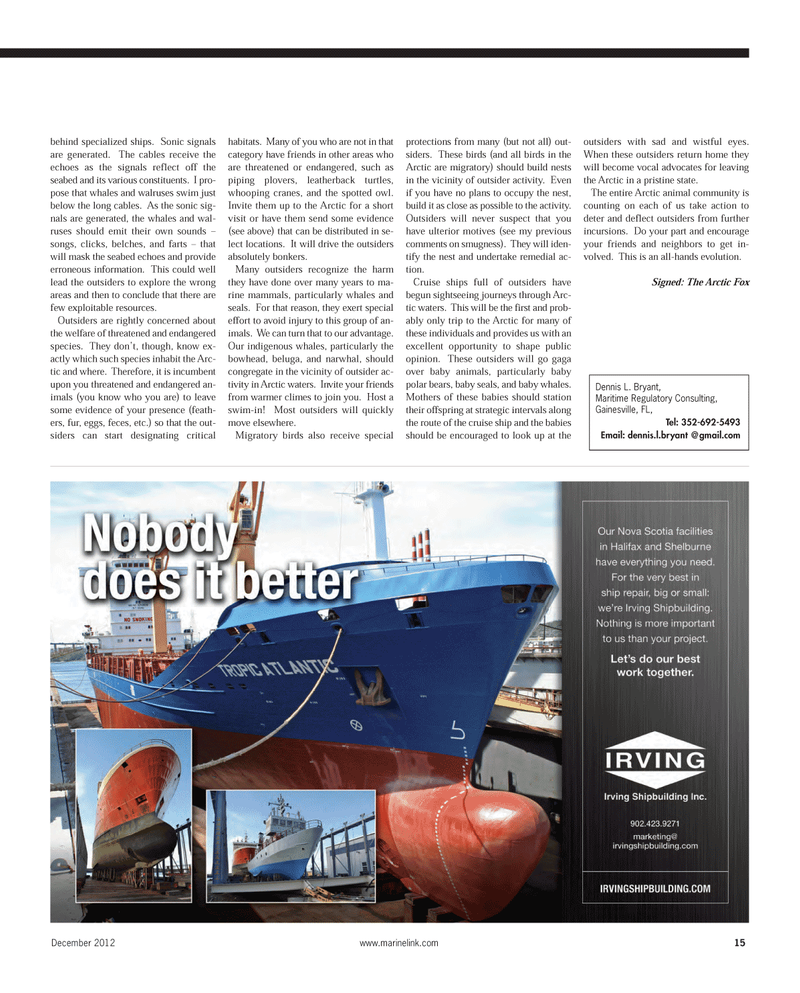
Page 15: of Maritime Reporter Magazine (December 2012)
Great Ships of 2012
Read this page in Pdf, Flash or Html5 edition of December 2012 Maritime Reporter Magazine
December 2012www.marinelink.com 15behind specialized ships. Sonic signalsare generated. The cables receive the echoes as the signals reflect off the seabed and its various constituents. I pro- pose that whales and walruses swim just below the long cables. As the sonic sig- nals are generated, the whales and wal- ruses should emit their own sounds ? songs, clicks, belches, and farts ? that will mask the seabed echoes and provide erroneous information. This could well lead the outsiders to explore the wrong areas and then to conclude that there arefew exploitable resources. Outsiders are rightly concerned aboutthe welfare of threatened and endangered species. They don?t, though, know ex- actly which such species inhabit the Arc- tic and where. Therefore, it is incumbent upon you threatened and endangered an-imals (you know who you are) to leave some evidence of your presence (feath- ers, fur, eggs, feces, etc.) so that the out- siders can start designating criticalhabitats. Many of you who are not in that category have friends in other areas who are threatened or endangered, such aspiping plovers, leatherback turtles, whooping cranes, and the spotted owl. Invite them up to the Arctic for a short visit or have them send some evidence (see above) that can be distributed in se- lect locations. It will drive the outsiders absolutely bonkers. Many outsiders recognize the harm they have done over many years to ma- rine mammals, particularly whales andseals. For that reason, they exert special effort to avoid injury to this group of an- imals. We can turn that to our advantage. Our indigenous whales, particularly thebowhead, beluga, and narwhal, should congregate in the vicinity of outsider ac- tivity in Arctic waters. Invite your friends from warmer climes to join you. Host a swim-in! Most outsiders will quicklymove elsewhere. Migratory birds also receive special protections from many (but not all) out- siders. These birds (and all birds in the Arctic are migratory) should build nests in the vicinity of outsider activity. Even if you have no plans to occupy the nest, build it as close as possible to the activity. Outsiders will never suspect that you have ulterior motives (see my previous comments on smugness). They will iden- tify the nest and undertake remedial ac- tion.Cruise ships full of outsiders have begun sightseeing journeys through Arc- tic waters. This will be the first and prob- ably only trip to the Arctic for many of these individuals and provides us with an excellent opportunity to shape public opinion. These outsiders will go gaga over baby animals, particularly baby polar bears, baby seals, and baby whales.Mothers of these babies should stationtheir offspring at strategic intervals along the route of the cruise ship and the babiesshould be encouraged to look up at theoutsiders with sad and wistful eyes. When these outsiders return home they will become vocal advocates for leaving the Arctic in a pristine state. The entire Arctic animal community is counting on each of us take action to deter and deflect outsiders from furtherincursions. Do your part and encourageyour friends and neighbors to get in-volved. This is an all-hands evolution. Signed: The Arctic Fox Dennis L. Bryant, Maritime Regulatory Consulting,Gainesville, FL, Tel: 352-692-5493 Email: dennis.l.bryant @gmail.com MR#12 (10-17):MR Template 12/3/2012 11:18 AM Page 15

 14
14

 16
16
